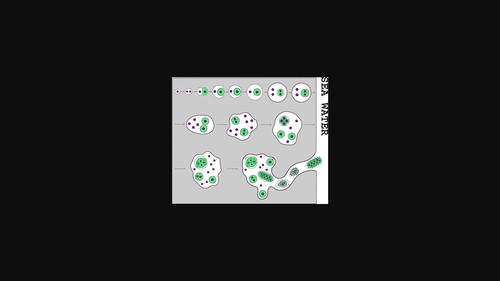当前位置:
X-MOL 学术
›
J. Morphol.
›
论文详情
Our official English website, www.x-mol.net, welcomes your feedback! (Note: you will need to create a separate account there.)
Plasmodium structure of Intoshia linei (Orthonectida)
Journal of Morphology ( IF 1.5 ) Pub Date : 2023-05-23 , DOI: 10.1002/jmor.21602 Elizaveta K Skalon 1 , Viktor V Starunov 1 , Natalya I Bondarenko 1 , George S Slyusarev 1
Journal of Morphology ( IF 1.5 ) Pub Date : 2023-05-23 , DOI: 10.1002/jmor.21602 Elizaveta K Skalon 1 , Viktor V Starunov 1 , Natalya I Bondarenko 1 , George S Slyusarev 1
Affiliation

|
Orthonectids are enigmatic parasitic bilaterians whose exact position on the phylogenetic tree is still uncertain. Despite ongoing debate about their phylogenetic position, the parasitic stage of orthonectids known as “plasmodium” remains underexplored. There is still no consensus on the origin of the plasmodium: whether it is an altered host cell or a parasitic organism that develops in the host extracellular environment. To determine the origin of the orthonectid parasitic stage, we studied in detail the fine structure of the Intoshia linei orthonectid plasmodium using a variety of morphological methods. The orthonectid plasmodium is a shapeless multinucleated organism separated from host tissues by a double membrane envelope. Besides numerous nuclei, its cytoplasm contains organelles typical for other bilaterians, reproductive cells, and maturing sexual specimens. Reproductive cells, as well as developing orthonectid males and females, are covered by an additional membrane. The plasmodium forms protrusions directed to the surface of the host body and used by mature individuals for egress from the host. The obtained results indicate that the orthonectid plasmodium is an extracellular parasite. A possible mechanism for its formation might involve spreading parasitic larva cells across the host tissues with subsequent generation of a cell-within-cell complex. The cytoplasm of the plasmodium originates from the outer cell, which undergoes multiple nuclear divisions without cytokinesis, while the inner cell divides, giving rise to reproductive cells and embryos. The term “plasmodium” should be avoided and the term “orthonectid plasmodium” could be temporarily used instead.
中文翻译:

Intoshia linei (Orthonectida) 的疟原虫结构
直行动物是神秘的寄生两侧对称动物,其在系统发育树上的确切位置仍不确定。尽管关于其系统发育位置的争论仍在继续,但被称为“疟原虫”的直连动物的寄生阶段仍未得到充分研究。关于疟原虫的起源仍然没有达成共识:它是改变的宿主细胞还是在宿主细胞外环境中发育的寄生生物。为了确定直连虫寄生阶段的起源,我们详细研究了Intoshia linei的精细结构直连疟原虫采用多种形态学方法。直连疟原虫是一种无形的多核生物,通过双层膜包膜与宿主组织分开。除了众多的细胞核外,它的细胞质还含有其他两侧对称动物、生殖细胞和成熟性样本的典型细胞器。生殖细胞以及正在发育的直连雄性和雌性细胞都被一层额外的膜覆盖。疟原虫形成指向宿主表面的突起,并被成熟个体用来从宿主中排出。所得结果表明直连疟原虫是一种细胞外寄生虫。其形成的一种可能机制可能涉及寄生幼虫细胞在宿主组织中传播,随后产生细胞内细胞复合物。疟原虫的细胞质起源于外细胞,外细胞经历多次核分裂,但没有胞质分裂,而内细胞分裂,产生生殖细胞和胚胎。应避免使用术语“疟原虫”,可暂时使用术语“直连疟原虫”。
更新日期:2023-05-23
中文翻译:

Intoshia linei (Orthonectida) 的疟原虫结构
直行动物是神秘的寄生两侧对称动物,其在系统发育树上的确切位置仍不确定。尽管关于其系统发育位置的争论仍在继续,但被称为“疟原虫”的直连动物的寄生阶段仍未得到充分研究。关于疟原虫的起源仍然没有达成共识:它是改变的宿主细胞还是在宿主细胞外环境中发育的寄生生物。为了确定直连虫寄生阶段的起源,我们详细研究了Intoshia linei的精细结构直连疟原虫采用多种形态学方法。直连疟原虫是一种无形的多核生物,通过双层膜包膜与宿主组织分开。除了众多的细胞核外,它的细胞质还含有其他两侧对称动物、生殖细胞和成熟性样本的典型细胞器。生殖细胞以及正在发育的直连雄性和雌性细胞都被一层额外的膜覆盖。疟原虫形成指向宿主表面的突起,并被成熟个体用来从宿主中排出。所得结果表明直连疟原虫是一种细胞外寄生虫。其形成的一种可能机制可能涉及寄生幼虫细胞在宿主组织中传播,随后产生细胞内细胞复合物。疟原虫的细胞质起源于外细胞,外细胞经历多次核分裂,但没有胞质分裂,而内细胞分裂,产生生殖细胞和胚胎。应避免使用术语“疟原虫”,可暂时使用术语“直连疟原虫”。



























 京公网安备 11010802027423号
京公网安备 11010802027423号